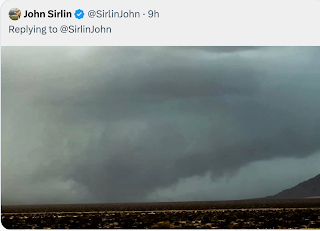Congratulations, AccuWeather!
The "eye" of the Snowicane over western Long Island
AccuWeather's forecasters realized all this as the storm developed. Given that huge numbers of people who would be without power in the cold surrounded by deeply drifted snow, they coined the term Snowicane to differentiate it from an ordinary blizzard. Since it would have a tight circulation similar to a hurricane (note the "eye" in the radar image above) and barometric pressure similar to a Category 2 Hurricane the term was apt.
The graph of barometric pressures was just like a hurricane's
I continued to read my Sunday paper and turned to page 12A and read this story about the power outages in the Northeast which states,
CONCORD, N.H. —Frustration turned to resignation Saturday for hundreds of thousands of people in the Northeast struggling to survive another day waiting for utility crews to restore electricity after powerful storms socked the region with heavy snow, rain and hurricane-force winds.
The highest wind reported from the storm was 91 mph off the coast of Portsmouth, N.H. —well above hurricane force of 74 mph. Gusts also hit 60 mph or more from the mountains of West Virginia to New York's Long Island and Massachusetts. [Note, there were even stronger winds as my friend Jesse Ferrell documents in his blog]
Hmm. "Hurricane force winds + heavy snow + westward moving storm + eye and banded structure" = "Snowicane" anyone? By getting the word out, AccuWeather gave people the vital tool of information which they could use to buy a generator, stock up on food and medicine, top off the gasoline tank, etc., to mitigate the effects of the storm.
Anyone who has read this blog or who will read Warnings knows that I am a fan of the National Weather Service. They do vital work for the pubic and we in private-sector meteorology depend on their data infrastructure. But, the griping about AccuWeather's clever way to get people's attention in advance of an extremely dangerous storm should have earned kudos rather than criticism from our colleagues in the NWS.






Hi Mike,
ReplyDeleteMy problem with AccuWeather using the terminology of snowicane is the same one I have with the NWS using Tornado Emergencies. It weakens the message of "ordinary" storms, which, I might add, still have the potential to destroy life and property. You yourself have come out against the use of Tornado Emergencies. How is this any different?
Where do we stop? What will AccuWeather call the next event that is bigger than this one? If I'm a resident in the NE and I survived this event just fine, I guess I don't need to worry about ordinary nor'easters or blizzards because even "snowicanes" don't really affect me.
Pat,
ReplyDeleteI see the two issues as different. But, because this (at least to me) requires more words than I can write in a comment, I am going to do a separate posting. Thanks for the suggestion.
Mike